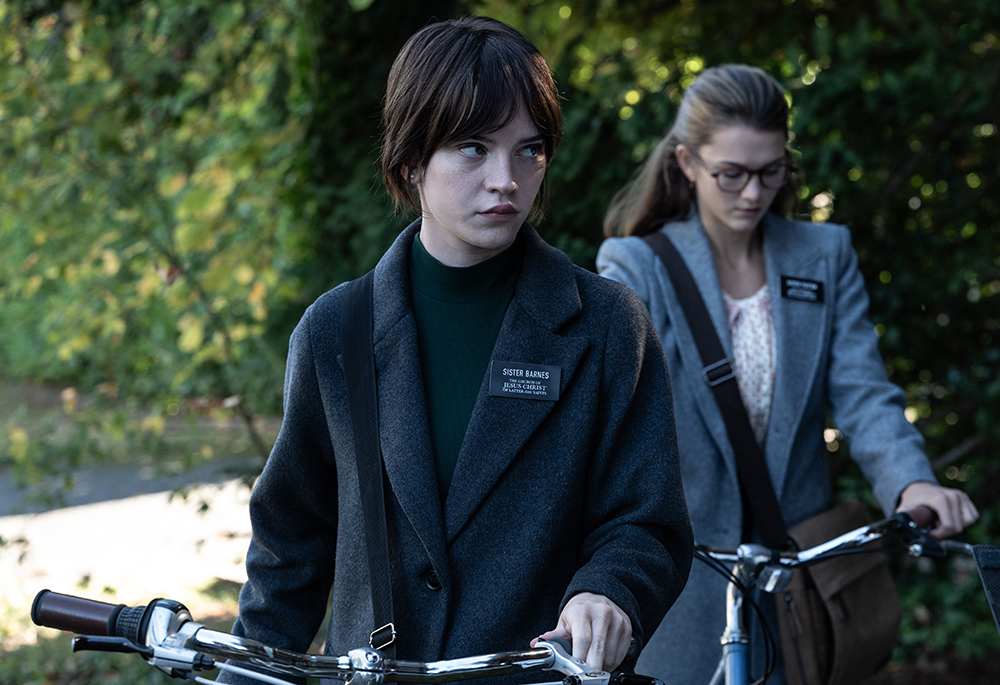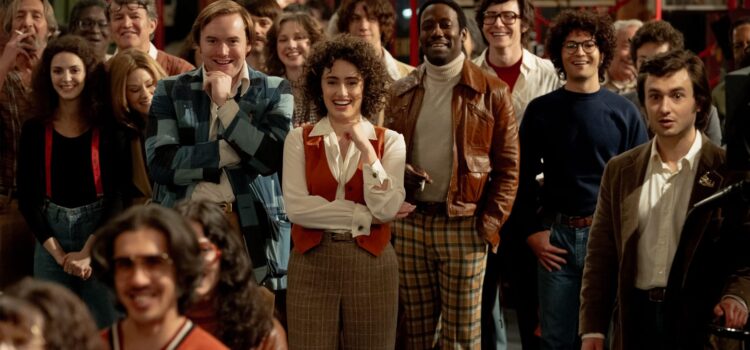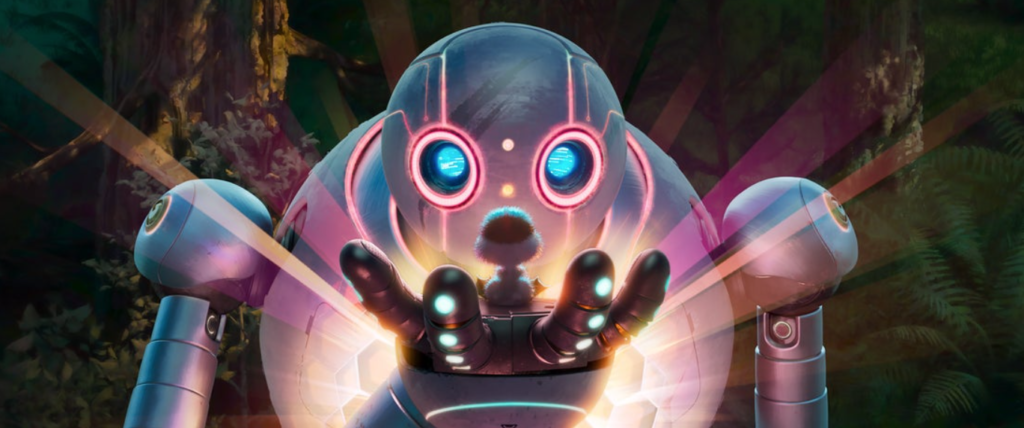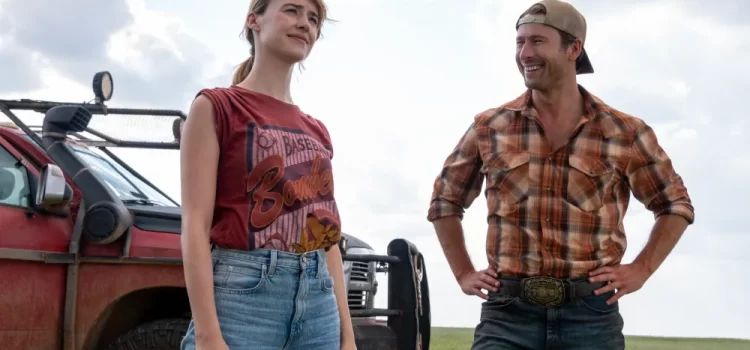By Alex McPherson
In large part due to a deliciously sinister performance from Hugh Grant, co-directors Scott Beck and Bryan Woods’ “Heretic” is a taut, suspenseful slice of horror that strikes an unwieldy but entertaining balance between big ideas and blood-soaked chills.
We follow two young Mormon missionaries, Sister Paxton (Chloe East) and Sister Barnes (Sophie Thatcher), on a seemingly innocent quest to proselytize about the tenets of the Church of Jesus Christ of Latter Day Saints (LDS) in a small mountain town.
Sister Paxton has been a member all her life, her faith passed down to her by her parents. Sister Barnes is a more recent convert — trauma-hardened and steadfast, finding in Mormonism a way to cope with past family tragedy.
Paxton and Barnes travel door-to-door and are used to being turned away, even publicly humiliated, but when they’re invited to the home of an older gentleman named Mr. Reed (Grant), they see a chance for a new convert — potentially Paxton’s first! When they show up at Mr. Reed’s deceivingly modest cottage, everything seems fine, initially.
A thunderstorm is raging, so Mr. Reed (donning a cozy cardigan) welcomes Paxton and Barnes inside, reassuring them that his wife is in the kitchen baking a blueberry pie.
But all is certainly not as it seems. Mr. Reed, radiating charisma (Grant’s specialty), begins to poke at Paxton and Barnes’ beliefs — questioning their personal histories in the Church as well as, in an awkward shift, how they square the Church’s doctrines with Joseph Smith’s practice of polygamy. The Sisters (especially Barnes) push back against his assertions.
Mr. Reed’s mansplaining leaves little room for counterargument, and the Sisters uncomfortably balance standing up for themselves with going along for the sake of getting to leave the house sooner. At least, that’s what they’re hoping.

But remember that blueberry pie? Barnes notices that its smell is being simulated by a scented candle on the living room table. The front door is also locked, and, thus, they’re forced to venture further into Reed’s puzzle-box-esque abode. Reed is certainly not finished with his pop-culture-laden TED talks on the nature of faith as business. And the Sisters must play along, or else, as Reed ultimately seeks to sell them on what he views as the “Ultimate Religion.”
Beck and Woods’ film — for all its “high-minded” talk of faith and free will — prizes entertainment above much else. It’s a haunted-house-monster movie with a pompous mansplainer strutting his stuff, reasonable conversation be damned.
Although the well-crafted suspense and incisive dialogue of the first half devolves into rushed twists later on, “Heretic” ascends to new levels of enlightenment thanks to a wonderfully creepy performance from Grant, who uses his characteristic charm to fiendish ends.
In a just world, Grant would be in the awards consideration. Committing completely to the film’s over-the-top swings, he renders Mr. Reed a deceivingly plausible villain, disguising his rotten core beneath a veneer of interpersonal niceties. There’s an obvious glee in the way he manipulates the Sisters.
Mr. Reed is giddy at another chance to voice himself, luring the vulnerable into his lair and daring them to fight back, with no “correct” answers to the questions he poses.
It’s impossible to take your eyes off Grant whenever he’s on screen. He’s definitely evil, but there’s a strange appeal in watching him walk Sister Paxton and Sister Barnes towards their fates, and “Heretic” doesn’t discount the incisive points he makes about modern religion. Rather, it acknowledges their validity while underlining the real horror at play — the insidious ways Mr. Reed imposes his views on others.
The film refuses to make a statement on the literal “truth” of religion itself, zeroing in on the psychological functions it can serve instead.
Mr. Reed is high off his own ego and his alleged understanding of human behavior, wrapping his takedown of religion around the idea of iteration, with every new belief system building upon the other in the name of the wealthy and privileged exerting power over the masses.
He throws in everything from Monopoly to Lana Del Rey to the “Star Wars” prequels to illustrate his point, complete with a blasphemous impression of Jar Jar Binks. It’s to the film’s, and Grant’s, credit that Mr. Reed never becomes too irritating.

The rest of the film, while not operating quite on the same level as Grant, impresses nevertheless. East and Thatcher are capable leads — likable from the first scene onwards, and never letting their characters slide into caricature. Thatcher’s world-weary turn conveys Sister Barnes’ hurt and perseverance. East, with a bubbly screen presence, conveys Sister Paxton’s relative innocence and surprising layers.
Philip Messina’s production design is outstanding in how off-kilter it makes the Reed residence seem — a twisted puzzle-box of interlocking parts that Mr. Reed maintains like a master conductor. Chung Chung-hoon’s cinematography reflects this idea, confidently flowing throughout spaces as if pre-ordained to do so, smoothly on-rails and mechanical, also using close-ups to suspenseful effect.
Beck and Woods’ wry screenplay incorporates plenty of humor throughout its accessible discussions of faith and control, and it delights in misdirection. It’s disappointing that third-act twists (particularly Mr. Reed’s final intentions) are spelled out so bluntly, however, somewhat abandoning the slow-burn satisfaction of what came before.
Indeed, when “Heretic” opts for more standard horror movie set-pieces (bringing plenty of blood and gore to the table) and reveals that stray far from believable, it’s less easy to become swept up in. And the ending, while thought-provoking and up to interpretation, is still frustratingly abrupt.
This remains one of the year’s stronger horror films in a year that’s already been full of them. Watch it for Grant if nothing else. His acting chops are certainly not up for debate.
“Heretic” is a 2024 psychological thriller-horror film written and directed by Scott Beck and Bryan Woods, and starring Hugh Grant, Chloe East and Sophie Thatcher. It is rated R for some bloody violence and the runtime is 1 hour, 51 minutes. It opened in theaters Nov. 8. Alex’s Grade: B+.

Alex McPherson is an unabashed pop culture nerd and a member of the St. Louis Film Critics Association.









































